Mike Taylor and his dad take a ride up through Norway to reach the fabled Nordkapp
Back in 2008, my dad visited Norway with my mum on his GS. He retired this year and wanted to take a trip with me back up to the Lofoten Islands, a group of islands in the northwest of the country, sort of like the Norwegian Outer Hebrides.
I had done some research on Norway and decided it would be good to visit Geiranger and ride the Trollstigen (Troll Road) on the way. While planning the route over a few beers we figured if we were going as far up as Lofoten we may as well carry on to Nordkapp. A few beers more led us to decide if we were going that far then we may as well head east after Nordkapp and go to Russia. So that was our rough plan.
We were both riding Africa Twins adorned with metal panniers and various Touratech and Rugged Roads farkles. Loaded on the back were our tents and camping gear. Ferries were booked and last-minute visas were arranged for Russia. There is no longer a ferry from Scotland or England to Norway, but when my dad last visited he got a ferry to Bergen from Newcastle and returned to Scrabster but we had to make do with the usual Newcastle to Ijmuiden sailing.
We had twenty-three days to do our trip. We figured it would be about 5,000 miles, and we wanted to spend a couple of nights at a few places. This would mean a few longer days on the road but our goal would be pretty achievable as long as nothing went Pete Tong.

I was getting quite nervous on the lead up to the trip. Pre-trip jitters are common for loads of folk, but on the day we left I was feeling pretty low, I don’t know what was up with me, but I didn’t feel too great waving goodbye to family and friends that had come to see us off. Luckily the feeling passed, an hour or so on the bike heading down to England sorted my head out, and by the time we arrived at North Sheilds for the ferry I was feeling good.
The ferry is a great start to a bike trip. You either meet loads of folk like yourself who are heading off on their own adventure, or you meet people who are heading home and are buzzing from their holiday. We met up with my mate Charlie and his family who were heading off in a camper van and looked over our maps. Dad and I never really had a proper plan. No accommodation was booked, no route was planned. When we arrived in Ijmuiden we just set the SatNav for Sweden and off we went.
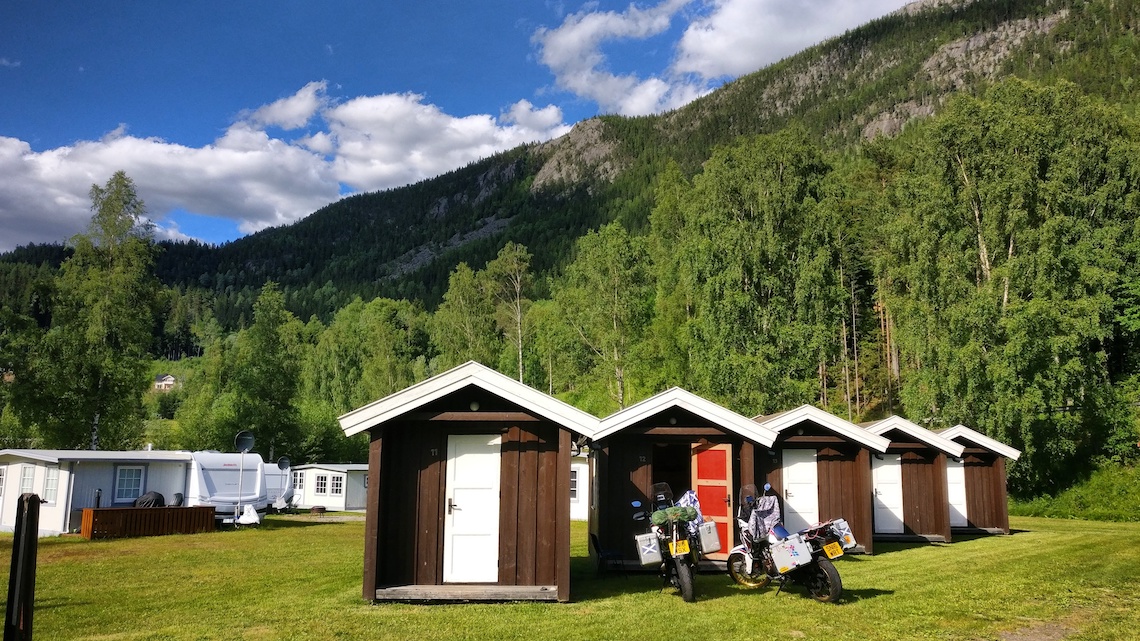
My SatNav was well out of date (I’m too tight to pay the £70 to update the old Zumo 550) and dad had forgotten to update his, making navigating our way out of Holland a bit hit or miss. Never mind though, the sun was shining and in no time we had battered out of Holland, across Germany and into Puttgarden where you catch the ferry over to Rødby in Denmark.
That night we stayed in the small town of Maribo, which turned out to be a great shout. It’s a beautiful wee town right by a lake on the Danish island Lolland. It was the perfect place for our first night. We got the tents up and wandered into town for some food before chatting with Michael over a beer back on the campsite.
Michael was a Polish guy who lived in Nottingham and rode a V-Strom. When we told him about our plans he said he’d pretty much planned the same trip, but circumstances back home meant he couldn’t make it. We were riding his dream! It makes you feel pretty lucky to be setting off on your trip when someone says that to you.
Crossing the Øresund using the famous tunnel/bridge and we were in Sweden where we joined the E6 and headed up the west coast of the country. The E6 is a road that goes all the way from the south of Sweden, up through Norway and across to Kirkenes at the Russian border. It would be a major part of our trip that we would leave and join a few times along the way. A Burger King, Gothenburg’s rush hour and several hours of Swedish motorway saw us to a rest area.
We checked the map and the internet and found a campsite on Tjörn, an island linked to Sweden’s west coast by a couple of bridges. We’d be staying in a Hytte, (pronounced ‘hyit-eh’) a small cabin with basic facilities.
You’ll find loads of Hytter all over Sweden and Norway and they’re reasonably priced and offer an affordable alternative to tents. The west coast of Sweden has some great scenery which would be worth taking time to explore, but that would have to wait for another trip. Our goal was to get into Norway.
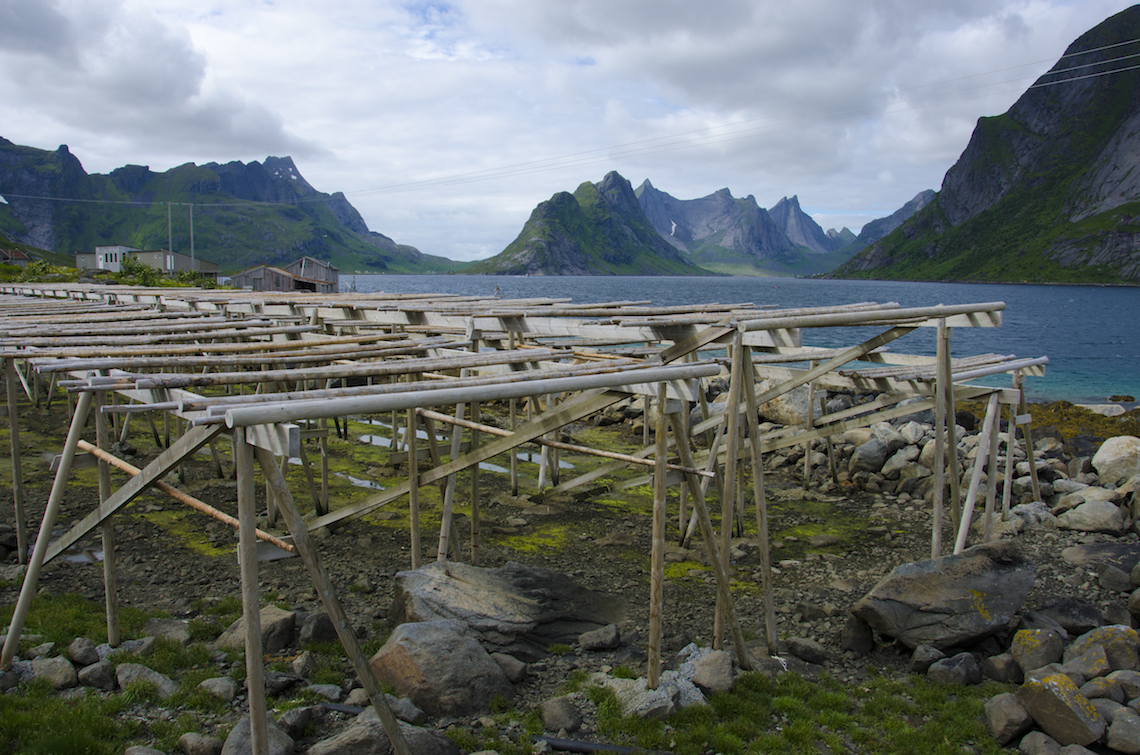
lines of racks on which stock fish is driedJust south of Oslo is the Oslofjord Tunnel, this allowed us to skip out the capital completely and head west away from the E6. I had been told that the E6 north of Oslo was dishwater dull, and decided to choose a route over the hills instead. We carried on west, heading through Drammen and further west towards the 40.
Since coming into Norway the low-speed limits were being observed fanatically. Norway has some of the strictest speed enforcement this side of Switzerland. Getting caught a few miles over the frustratingly low limit results in trip-finishing fines. Slow and steady was the way forward.
We joined the 40 at Kongsberg. I had spent so much time on long, straight motorways and A class roads that I thought I’d forgotten how to corner. The 40 soon reminded me how. Even with the 80kph (50mph) speed limit, the 40 was a great road and I quickly got used to chucking the Africa Twin about.
Another Hytte was found at Norefjord for the evening’s accommodation where the night was spent watching a local guy pull wheelies while we looked at maps and drank beer. As always, I was jacked into the WiFi and, according to folk on Facebook, we were in for a good run tomorrow.
They were right. Riverside roads climbed Alp-like switchbacks out of the trees onto high open plateaus. Mutant shaped mountains wore snow caps and signs appeared warning us to keep an eye out for reindeer and moose. Before, Norway had looked a bit like the Black Forest or Austria, but now it was showing some of its own personality. Geirangerfjord is one of Norway’s most famous landmarks and, along with the Trollstigen, a bit of a mecca for bikes.
We were lucky to hit it a bit later on, I don’t get all these people who get up early, like everyone else, to get the roads to themselves. Have a long lie-in and get there fashionably late, you’re on holiday! The road was stunning, the sun pumped out 26C heat while the lakes were still frozen, and the roadside was a patchwork of snow. I was stopping every few miles for photos, Norway really is a place where you can wear out your camera.
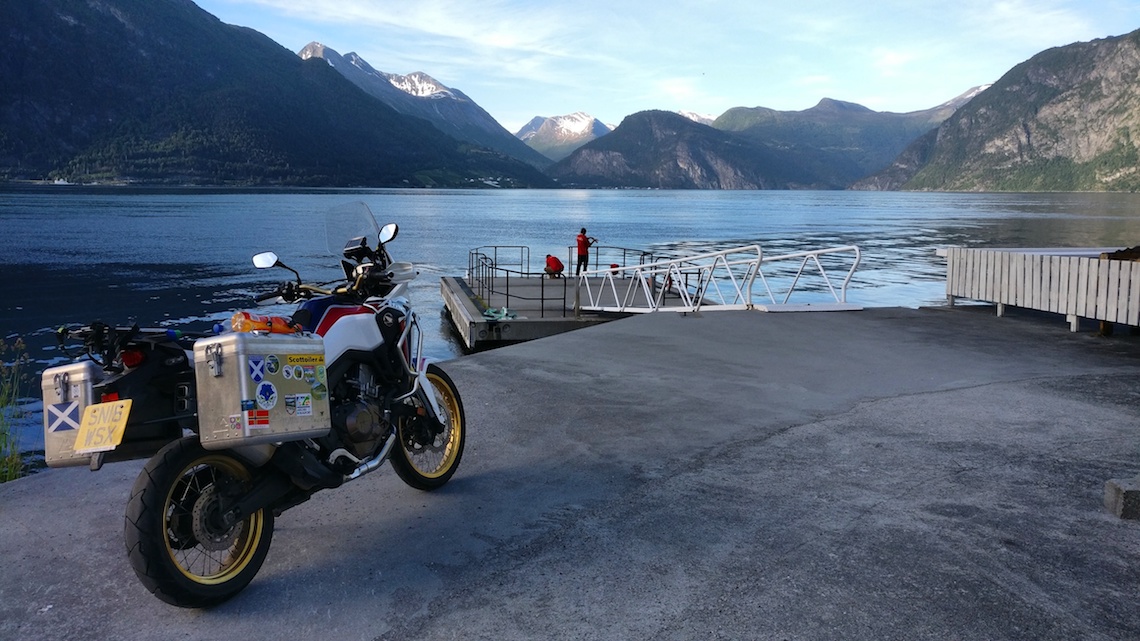
The scenery is mindblowing, and it keeps getting better and better. After a while it becomes ridiculous, you need to just pull the bike over and build up a tolerance to stop overdosing. Researching the trip I’d seen plenty photos of Geiranger and the fjord, but when I got there and saw it with my own eyes I actually blurted out “F***ing calm doon Norway!” It is incredible.
As you can imagine, somewhere as stunning as the Geirangerfjord attracts plenty of tourists. The town of Geiranger is quite small so we headed over another set of awesome switchbacks, through the hills and down to Eidsdal where you get the ferry over to the 63; the famous Trollstigen.
Dad had stayed at Eidsdal before but unfortunately, the campsite had been taken over and closed to the public. Luckily there was another place a few miles along the road at Norddal, we got the tents up and I rode back along to the shop.
Everyone had said that Norway was expensive, however, we’d found it to be relatively OK so far. Well, this shop held on to the stereotype with both hands. As I hunted for something we could make a meal of I was mentally exchanging currencies. I got some cold meat, some cheese, Ritz crackers, two apples, a double Snickers bar and six beers. The cost in pounds? Forty-two quid!
We were just setting up to tuck in when some Norwegian’s came over to say hello. They’d had a barbecue and had loads left over. Suddenly our snack had turned into a feast and by the time I finally got into my tent it was 2 am. It had barely gotten dark.
Ferries in Norway are cheap and hyper-efficient. In no time we were riding north on the 63 towards the fabled Trollstigen. I don’t know if the previous day’s scenic overindulgence had blunted my appreciation, or if I’d built up a strong tolerance to stunning scenery, but the Trollstigen, for me, wasn’t a patch on the road to Geiranger. I had been told by one of the Norwegians from the night before that it’s much better riding it from north to south. Don’t get me wrong, it’s not bad, far from it.
But it didn’t have the “calm doon Norway” element. Dad noticed a big difference since his last visit. He said that at the top there used to be a bunch of little huts selling the usual tourist stuff, whereas now there’s a big, fancy modern looking visitor centre.
Everything calmed right down as we rejoined the E6. 50mph feels really slow on such an open road. With no corners or overly dramatic scenery to occupy my short attention span my concentration started to waiver.
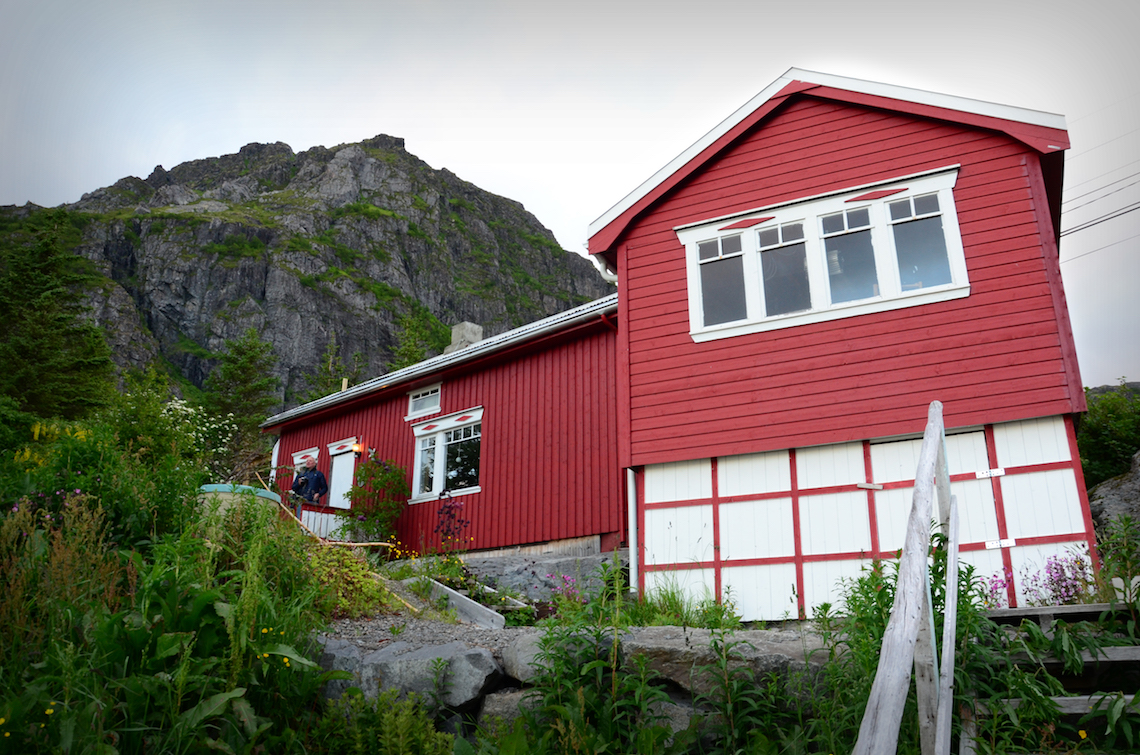
I really found the run-up to Mo i Rana a long, tough drag. Who’d have thought going so slow was so tiring? We spoke to a lass with a tuned-up Gixxer at a fuel stop. I was thinking how frustrating it must be having such performance at your fingertips but such Stasi like speeding laws.
“Have you been caught speeding?”
She had. 59 in a 50 zone. The fine? The equivalent of £450. Ouch. She reckoned it was money well spent.
Mo i Rana is quite a large town just south of the Arctic Circle. Being Saturday night dad and I wandered into town for some food, choosing a nice pizzeria. There was some seriously impressive machines driving around, from big American muscle cars to an immaculate Z1B kwaker.
After our pizzas we wandered around for a bit, checking out the Havmannen, a huge sculpture in the sea just beside the town, before stumbling upon a woodcutter themed pub. A couple of beers each later (forty quid) and we headed back up to our digs.
The pub had been slightly disappointing as we were the only people in the place. Norway seems to lack any real pub or café culture so it was a bit harder to meet local folk, something I enjoy about travelling. Facebook on the other hand was reeling in the results.
I had found a Norwegian bike group and put up a recommendation request for any accommodation that was available near Å on Lofoten. Ole and Lena responded saying they had a ‘small house’ just up the road from Å that we could have, no charge! Dad couldn’t believe it.
“So this guy, who you’ve never met in your life, is letting us use his house?” He asked.
“Yep dad, good eh?”
“He’s letting ye use his house. For free. And you don’t know him at all?”
“Aye dad, he’s called Ole.”
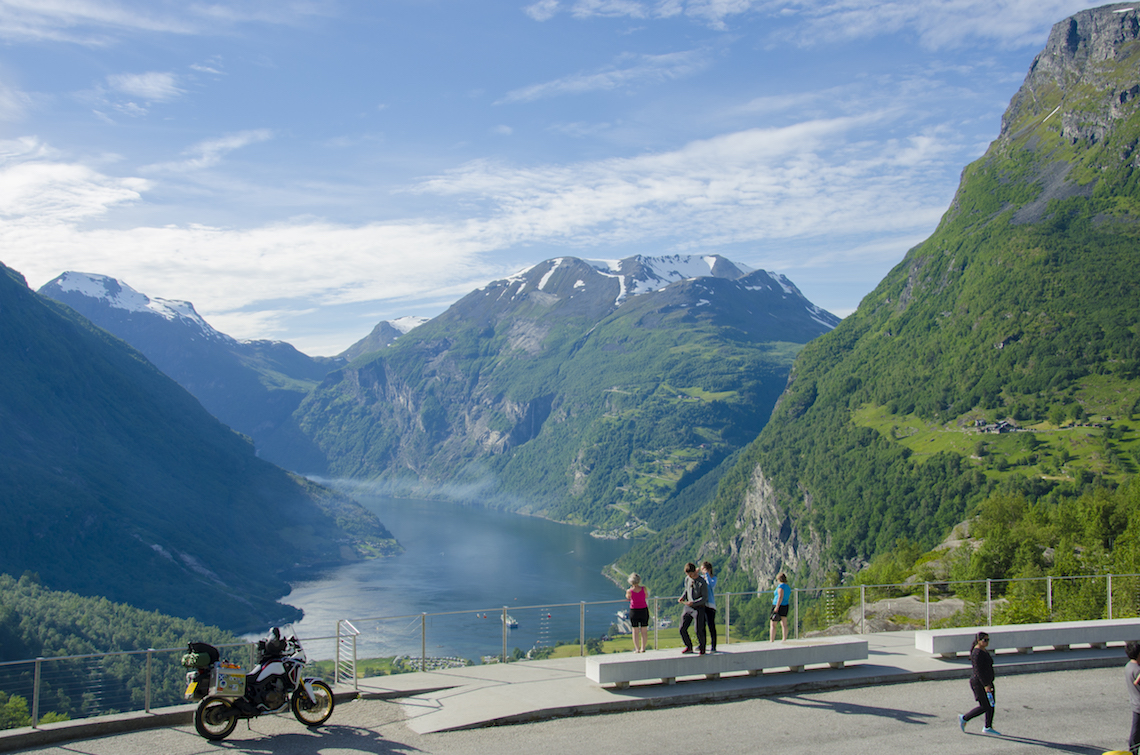
Our Mo i Rana accommodation was a wee apartment beside the campsite, dad wasn’t keen on the tent and there were no Hytter available. In the apartment next door, was Björn and his wife. Björn was a whale hunter from Tromsø.
We’d brought some Whisky with us from back home which we shared with Björn and Mrs Björn (I’m terrible with names). He had been to a fair number of places on his boat including Murmansk, one of the major destinations on our route.
“What do you think of Murmansk, Björn?”
“Murmansk? Murmansk is a f**king s***ty city. They’re corrupt motherf**kers. They’ll steal anything. Your bikes, they won’t be safe.”
Needless to say, Björn wasn’t a fan of Murmansk. The conversation then turned to Björn’s line of work. I said I wasn’t going to sample any whale meat while on our travels. I’ve never even seen a whale in the flesh, so I didn’t want to start shovelling said flesh into my guts.
Björn got a bit animated by this, asking if I thought that he shouldn’t be allowed to make his living hunting whales. I told him that whale hunting was part of his country’s culture and it wasn’t really my place to judge. Sure, I don’t agree with it, but whale watching is more popular back home. I guess part of travelling is meeting different cultures and practices. You’re not going to agree with them all.
We carried on our discussion into the midnight sun. Björn assured me that whale hunting is sustainable and showed me photos of the tools of his trade which he said gave minimal suffer- ing to the whale. It was good speaking with Björn, he wasn’t shy to share his opinion, when we first met him I thought he was a bit of a tool, but in the end, I enjoyed his company. I still never tried any whale though.
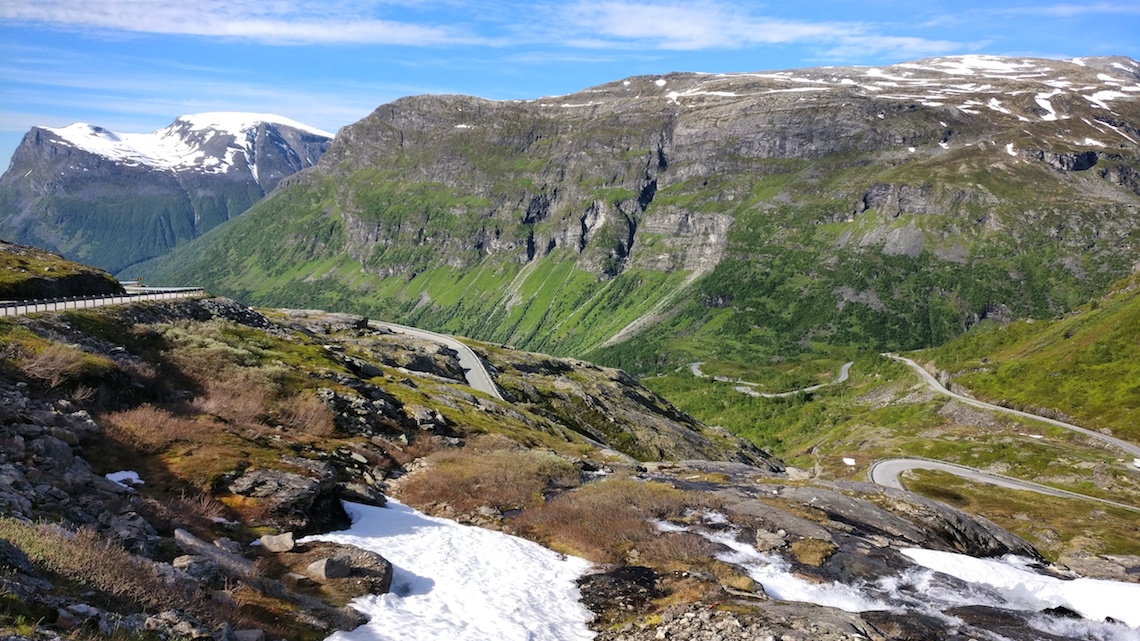
We awoke to a wet morning, the first real rain of our trip so far. About an hour or so north of Mo i Rana the road begins to climb steadily up before opening out to another plateau. This one felt different, it was a fair bit colder and the rain added to the atmosphere. Shortly after we crossed the Arctic Circle, the first real milestone that I had for the trip. We visited the Arctic Circle Centre, another tourist magnet, but definitely worth pulling in to see. Postcards posted, pannier stickers stuck, we set off again heading for Bodø where you get the ferry over to Lofoten.
After navigating our way through some pretty severe road- works we arrived at Bodø ferry terminal to be met by a long queue. The ticket collector was pretty confident she could squeeze us on so we went to warm up in the ferry terminal. There was a couple of hours to spare but it wasn’t till the last minute that we decided to try and get a couple of beers for that evening. The only problem being it was Sunday and hardly any shops were open.
I jumped on the Africa Twin and raced off into a Dakar inspired Dale Winton Supermarket Sweep, somehow finding my way into a closed supermarket. It turns out that no alcohol at all gets sold from shops in Norway on a Sunday. Still, it gave the folk who were restocking the shop a laugh.
Making it back to the ferry with literally seconds to go, bikes were secured and we found some seats. Hotdogs seem to be the only real affordable food in Norway and they’re served up everywhere, from ferries to petrol stations (petrol stations also serve up good coffee and other food. I accidentally bought a £14 ‘Dallas burger’ on the way to Geiranger. I’d thought it was a fiver). Hot dogs were ordered and questions asked.
“Are ye sure this guy’s for real? What if he’s taking the piss?” “I reckon it’s all good dad.”
“And he’s giving us this hoose for free?”
“Aye, look.”
Ole had messaged me directions to his house and instructions on how to get the key. I’d asked if he’d be coming to meet us, but Lena and he were away in Oslo.
“I cannae believe that yer getting a hoose for f**k all. That’s mental…”
Lofoten is crazy. The scenery is so dramatic it’s hard to get your head round it. You could stop every fifty metres for a photograph. I rode off the ferry with some apprehension. What happens if dad was right? The ferry gets into Moskenes just north of Å. Ole’s directions memorised, we rode south. Ole’s ‘small house’ appeared as we rounded a corner. It wasn’t that small either.
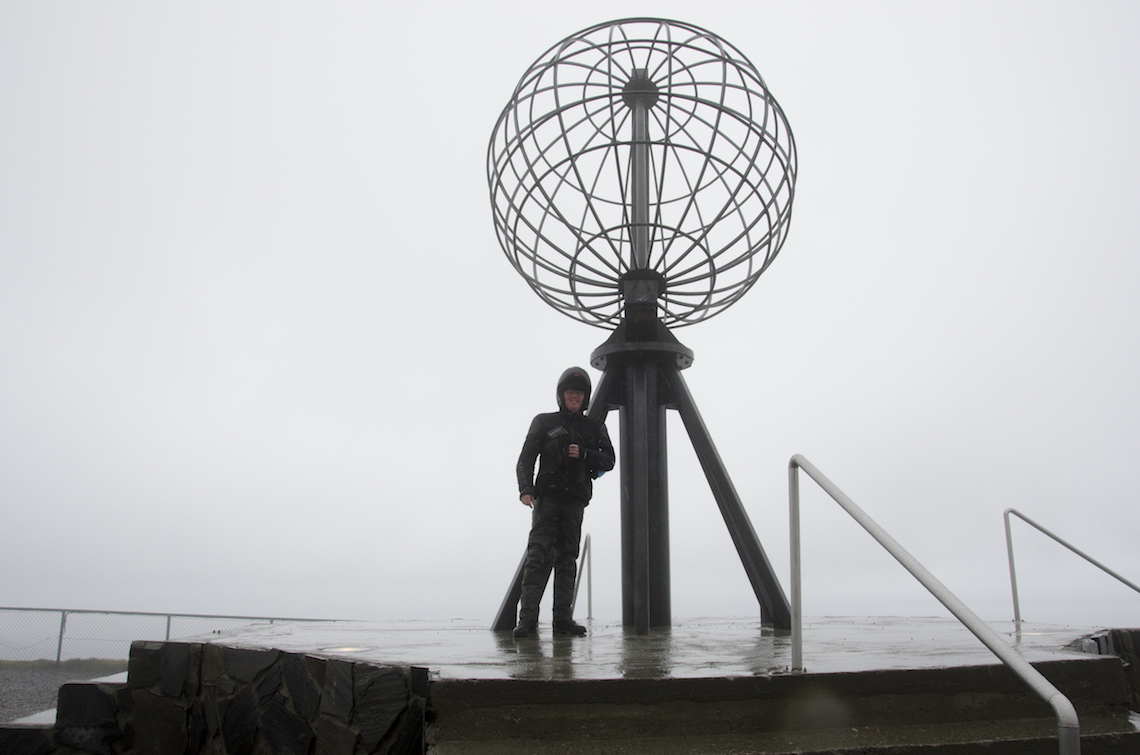
After getting the key and assuring his neighbour that we were allowed to be there, we unpacked the bikes. Lena and Ole’s house was phenomenal, a special wee sanctuary that I couldn’t believe we’d been given for free. Ole had sent me the wifi password and everything. “There’s beer in the fridge too.” What a guy.
The epic Geiranger road we spent two nights at Ole’s, exploring Å and the surrounding area, catching up on laundry and generally relaxing. Everywhere you go you’ll see these large wooden racks that are used for drying the Stockfish. Stockfish, an unsalted dried fish, usually cod, which hangs in pairs over the wooden racks to dry in the cold arctic air, is Lofoten’s main source of income. I tried some in Å, it’s very meaty and quite nice. There’s a lot of eating in it though, I couldn’t finish mine!
Fully refreshed and with laundered clothes, we said goodbye to Å. We had been so lucky in getting the house from Ole. If you are planning to visit Lofoten and want to stay in Å then make sure you book accommodation in advance. Wild camping is allowed in many parts of Norway, but I saw loads of “no camping” signs on Lofoten, especially around Å, so plan ahead.
Norway was back to its full-on, 100% pure, unrefined crazy, dramatic scenery. I had to stop myself from pulling over all the time as we rode north on the E10, which runs from Å up to Bjerkvik where it joins the E6. If you’re planning a visit to Nordkapp, make sure you take a visit to Lofoten.
Words like “awesome” and “phenomenal” are often overused. They just don’t cut it on Lofoten. Sure, it’s expensive, but man, you need to see the place, it’s phenome… It’s awes… It’s really, really good.
Back on the E6, I noticed a distinct change from when we’d turned off to Bodø. It was far colder, all the hills were covered in snow and the landscape was opening up, trees thinning out and being replaced by tundra. It began to feel like we were far away.
Towns grew further apart and shrunk in size, the traffic thinned out and the amount of reindeer cutting about the place increased. The photo-heavy ride up from Å had taken most of the day, so we only rode for an hour or so on the E6 before finding a Hytte for the night.
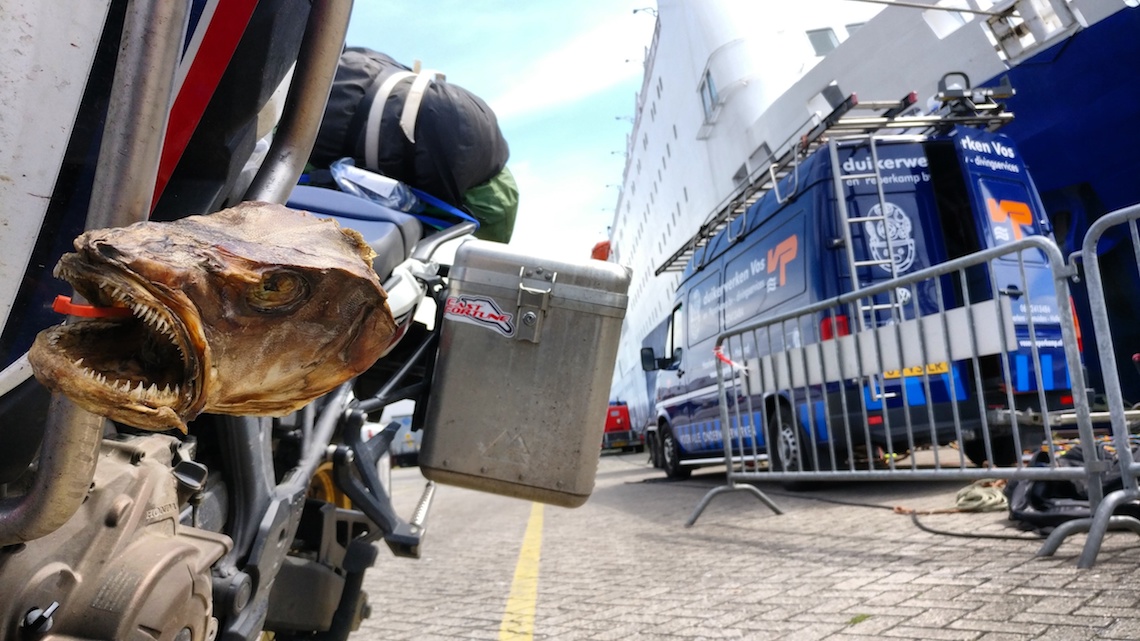
Everyone had told me that the E6 from Lofoten to Nordkapp would be a long, boring, tick box exercise. It was wet, cold, windy and exposed, but I thought it was amazing. I really felt like we were somewhere that not many people go. It felt far away from home. There was snow at the side of the roads, loads and loads of reindeer and not too many other folk on the road. I’d stopped for a photo when another bike rode past me and stopped in by dad.
The guy was Alexandr, a Russian from just outside Moscow. Alexandr was also headed for Nordkapp on his Varadero. We spoke with Alexandr for ten minutes or so. He had booked a place to stay up the road in Alta, whereas dad and I were planning to carry on a bit further. We agreed to keep an eye out for each other on the road to Nordkapp and set off.
We found accommodation at Oldefjord in the form of a tiny Hytte. Oldefjord is at the junction of the E6 and the E69, the road to Nordkapp. All that’s really there is a petrol station, a campsite and a hotel that also has a restaurant and a souvenir shop. We cooked a basic tea in the Hytte and had an early night, the next day we’d hopefully get to Nordkapp.
Nordkapp is the furthest north you can drive in continental Europe. Technically it isn’t the most northerly part of mainland Europe because it’s on a wee island linked to the mainland. But come on, who’s got time for that sort of pedantic thinking? We arrived there around lunchtime after a wet, windy but very enjoyable run up the E69.
I wouldn’t describe it as busy, but you need to keep your wits about you to dodge the occasional motorhome, tour bus or reindeer, none of which seem to bother what lane they use.
Despite the weather trying to give us a beating, I was buzzing when we finally got to Nordkapp. Even when a thick fog blew in just 500m away, I didn’t stop grinning. You need to pay a fee to get to Nordkapp itself. People complain about the 270 NOK (about £25) but when you consider where it is, and the infrastructure that’s been put in place to allow tourists to visit, I think it’s worth the price.
We bought souvenirs, ate some waffles, posted postcards and watched the brilliant short film in the cinema. Alexandr turned up and we all congratulated each other on making it to the top of Europe. Photos were taken then we jumped on the bikes and headed south.
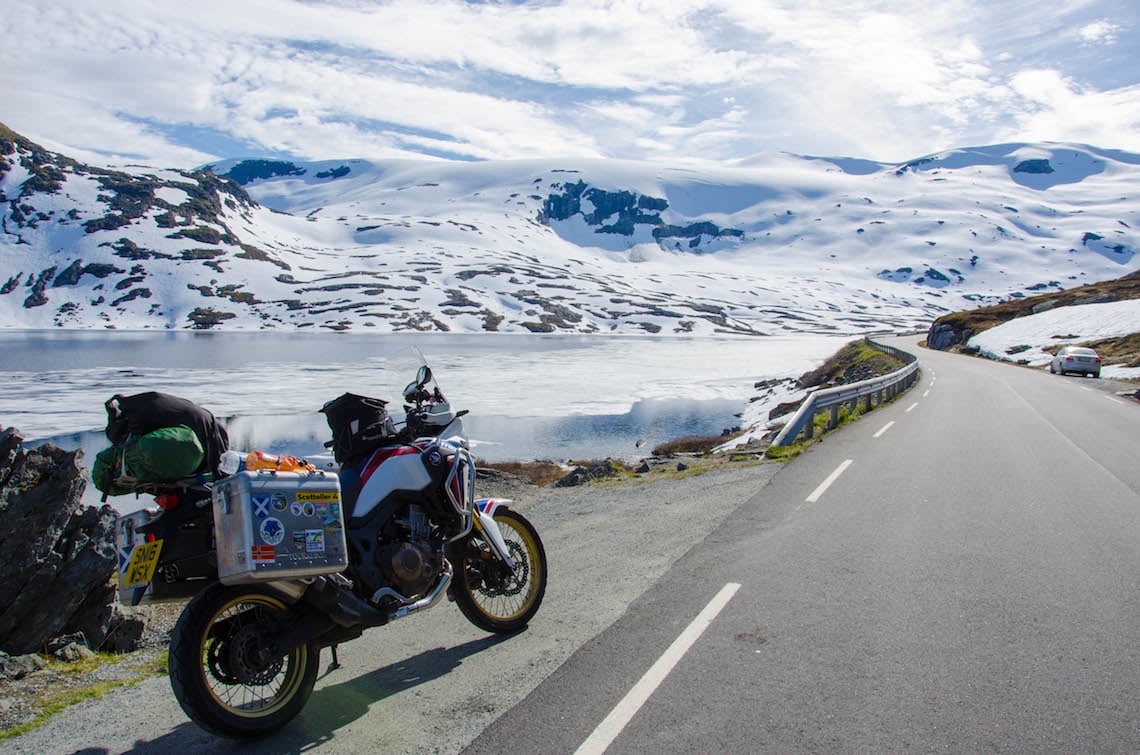
We got back to Oldefjord and refuelled. We had planned on trying to get a bit further east towards Kirkenes, but there was space in the hotel and already there were a few bikes parked up.
I smoked a big cigar I had brought with me to celebrate getting to Nordkapp while having a beer with Tomas, a GS rider from Switzerland.
Alexandr arrived and I shared the last of my whisky with him, Tomas and dad, where we all headed to the restaurant for a meal and a beer. We were sitting sharing travel tales when out of the window I saw a guy ride up on a tiny moped towing a bicycle trailer.
“Check out this guy! I’m going to have to go out and find out what he’s up to!”
Mats Hallin lives just outside Stockholm. He was riding to Nordkapp on his tiny, 50cc moped. He had carrier bags on his hands to keep warm and dry and wellies on his feet. He was doing his trip to raise money for a mental health charity. I invited him to join us and bought him a beer. We were all feeling like awesome adventurers having ridden to Nordkapp on our big bikes, when Mats comes along on his wee 50. It just shows you, you can tour on any bike.
Alexandr joined us on the ride to Kirkenes. We got on booking.com and got accommodation in the same place he’d booked, just 500m from the Russian border. The sun was back out, keeping us warm as we headed east, the E6 following the
Norwegian/Finnish border. I was riding along thinking about how, over the other side of the river to my right, there were different laws, languages, currencies and cultures. Borders are strange things.
Russia had been playing on my mind the closer we got. Even while being blown away by the scenery of Lofoten, or buzzing at arriving at Nordkapp, there was a Russian niggle in my guts. It wasn’t the border crossing that I was worried about,
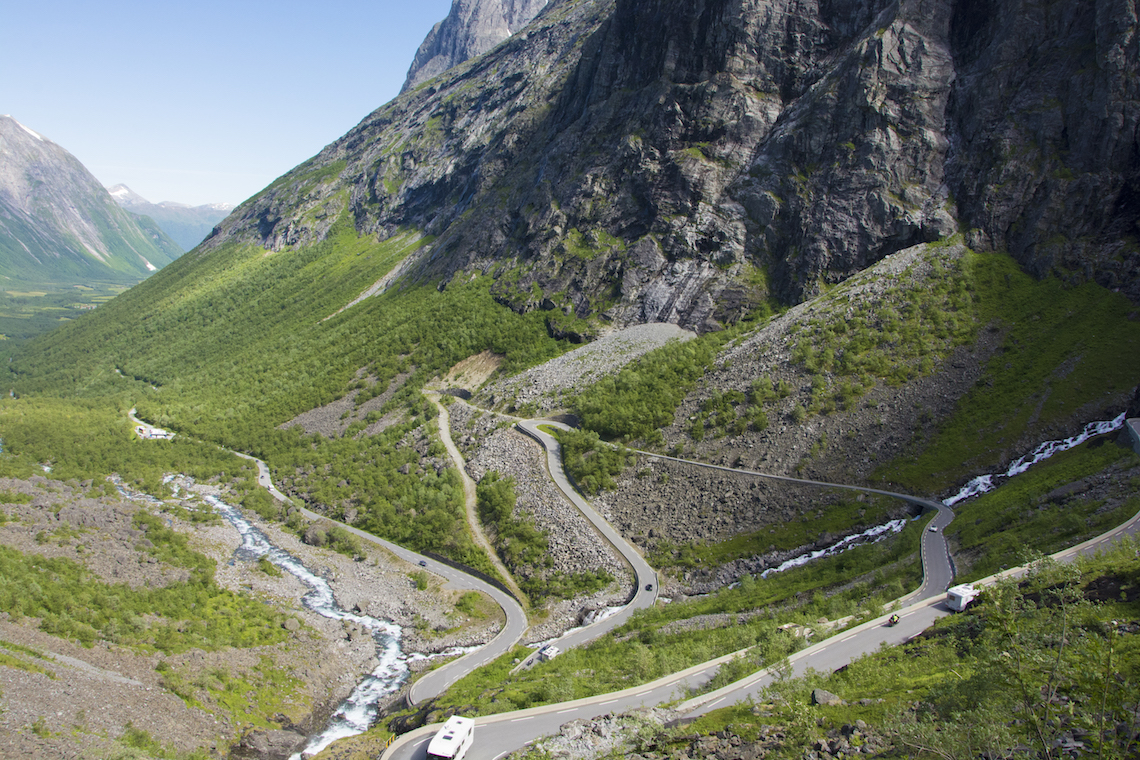
it was more a mix of the horror stories we’d been told and the great unknown. I had a rough route in mind but would the roads be open? Will we need to bribe the police and other officials? What about the bikes? Would we have secure parking? What about insurance? I kept telling myself there was no point in worrying about any of these questions, as we wouldn’t get any answers until we arrived in Russia. Even Alexandr didn’t know the answers.
One thing I knew was that we had to get was third party insurance, thanks to being informed on various internet forums. It wasn’t worth the paper it was written on, but if we didn’t have it and we were stopped by the police our bikes could be impounded.
Along with all the others, the insurance question would have to wait until the following day to get its answer. We found our accommodation easily, and over the road was a very Grand Designs looking restaurant right on the banks of Neitijärvi Lake. Joined by a German GS rider, we had our last meal in Norway while looking over the water to Russia and the border crossing.
The border crossing into Russia was relatively straightforward. We had to fill in various bits of paperwork about ourselves and the bikes, some of these were in Russian and I had to get shown what to write in each box. It took an hour and then it was back out to the bikes where a serious-looking Russian woman wanted to inspect the bike and my stuff.
It was nearly comical going through all my stinking clothes and showing her all the stuff I had with me. They even wanted to see inside my tent! They kept pointing to the cod head that I had cable tied on to my crash bar (a souvenir from Lofoten). Alexandr came to translate.
“This, no. No. Not in Russia.”
Gutted. I thought I’d have to get rid of my cod head that I’d carried from Lofoten. I got my knife out, which didn’t bother the border guards at all, and cut the cable ties.
“Put it in the box?” I asked pointing to my pannier.
Big smiles all round. “Da, yes yes. This is good.”
So, the cod head could go into Russia, just not be visible.
Welcome to Russia.
The Bikes
We both rode 2016 manual Honda Africa Twins. Both bikes were fitted with Honda’s high screen and recently upgraded heated grips. Both of which worked well, especially up at Nordkapp. Both bikes were fitted with Touratech upper crash bars. My bike had Touratech Zega Mundo Panniers. Dad’s bike had Bumot panniers.
The Bumots have the edge over the Touratech boxes in terms of build quality, but they were a wee bit more expensive and don’t sit on the bike as well as the Zegas, especially if you take a pillion.

Want to ride to Nordkapp?
How long to take off work?
If you’d just like to do Lofoten and Nordkapp you could do it in two weeks from Calais assuming you ride six to seven hours each day. Add an extra week if you want to come back via Russia. We took 25 days including the overnight ferry. This gave us time to have three two-night stops.
How much will it cost?
Scandinavia is expensive, there’s no getting away from it. I’d say a bare minimum budget will be £1,500, not including the cost of getting to the continent. This is assuming you’ll camp the whole way and occasionally wild camp. Plus, you’ll burn through a pair of tyres and you’ll need to make sure your bike has had a service. £2,000 spending/fuel money per person would give you some more luxurious options such as Hytte accommodation and an occasional meal out, plus a wild night and a good hotel in Russia.
Currencies?
To get around all the different currencies we used a pre-paid travel card. We went for the Revolut card (www.revolut.com) as it gave the best exchange rates with no fees. Once set up, it’s easily topped up from an app on your phone. The only downside was it didn’t work at pay-at-the-pump fuel stops, which is all they seem to have in Sweden. You can pay by card pretty much everywhere in Scandinavia and northwest Russia. I’d still advise on carrying some local currency, even if it’s just a small amount.
How to get there?
As there’s no longer a ferry from anywhere in the UK to Norway your options are either the crossings around Dover, the ferries from Hull, or the Newcastle to Ijmuiden ferry that we used. We rode up to Norway through Denmark and Sweden taking the ferry from Puttgarden to Rødby then crossing the Øresund Bridge. Your other option would be one of the ferries to Norway from Hirtshals in the north of Denmark. Whichever way you go it’ll be around 5,000 miles. Our trip was just under 5,500.
When to go?
For visiting Nordkapp by bike, the best time is the end of June, July and the start of August. It can still be very cold and wet up there, even in ‘summer’. It doesn’t get dark, so remember your eye mask.
What Documents do I need?
The usual documents like passport, V5 and insurance documents for the bike. We were advised to get an international driving permit for going in and out of Russia, although we were never required to show it. Carry a high viz for you and your pillion.
If going to Russia you should buy insurance at the border, or if they don’t sell it there you should get it at the next town or petrol station. Look for “страхование”. We never had to show our document but were warned if we were stopped and never had one, our bikes could be impounded.

